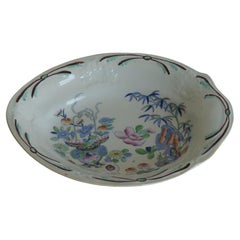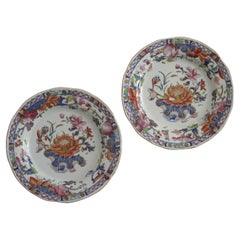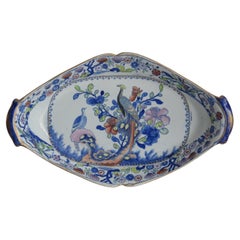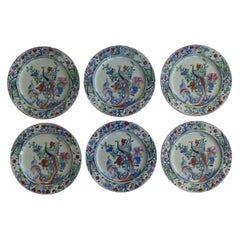Want more images or videos?
Request additional images or videos from the seller
1 of 21
Rare Pair of Stephen Folch Ironstone Soup Plates Oriental Pheasants, circa 1825
$588.05List Price
About the Item
- Attributed to:Stephen Folch (Manufacturer)
- Dimensions:Height: 1.25 in (3.18 cm)Diameter: 9.63 in (24.47 cm)
- Sold As:Set of 2
- Style:Chinoiserie (Of the Period)
- Materials and Techniques:
- Place of Origin:
- Period:
- Date of Manufacture:circa 1825
- Condition:Wear consistent with age and use. Overall Very Good Antique condition. One plate has more surface scratches and wear than the other. Some marks from the kiln. Small base rim nibble to one plate. NO Restoration.
- Seller Location:Lincoln, GB
- Reference Number:Seller: P 1209 & P 12101stDibs: LU990310692943
About the Seller
5.0
Platinum Seller
Premium sellers with a 4.7+ rating and 24-hour response times
Established in 1993
1stDibs seller since 2013
1,402 sales on 1stDibs
Associations
LAPADA - The Association of Arts & Antiques Dealers
Authenticity Guarantee
In the unlikely event there’s an issue with an item’s authenticity, contact us within 1 year for a full refund. DetailsMoney-Back Guarantee
If your item is not as described, is damaged in transit, or does not arrive, contact us within 7 days for a full refund. Details24-Hour Cancellation
You have a 24-hour grace period in which to reconsider your purchase, with no questions asked.Vetted Professional Sellers
Our world-class sellers must adhere to strict standards for service and quality, maintaining the integrity of our listings.Price-Match Guarantee
If you find that a seller listed the same item for a lower price elsewhere, we’ll match it.Trusted Global Delivery
Our best-in-class carrier network provides specialized shipping options worldwide, including custom delivery.You May Also Like
Pair of Midcentury Italian Figural Plates by Fidia
By Fantoni
Located in New York, NY
Fabulous Italian hand painted figural bowl and tray by Fidia. These big eyed girls are in the style of Fantoni. Bound in leather on the back these are gre...
Category
Vintage 1960s Italian Decorative Dishes and Vide-Poche
Materials
Ceramic
Pair Antique Wedgwood & Co. Plates in "Processional Elephant and Howdah" Pattern
Located in Katonah, NY
This pair of antique English dishes shows a fabulous bird's eye view of an elephant in an imaginary setting. Two figures ride an elephant throug...
Category
Antique Early 1800s English Chinoiserie Ceramics
Materials
Pearlware
$330 / set
H 1 in Dm 9 in
Pair of Colorful Ironstone Plates "Late Spode" England Circa 1835
By Copeland & Garrett Spode
Located in Katonah, NY
This pair of dishes feature a lively design of waterlilies and songbirds in a lovely array of colors.
The flowers are painted in shades of pink, yellow, and green, while the stems an...
Category
Antique 1830s Rococo Decorative Dishes and Vide-Poche
Materials
Ironstone
Sylvia Leuchovius, Large, Rare Decorative Plate / Platter, Scandinavian Modern
By rorstrand studio, Rörstrand, Sylvia Leuchovius
Located in Stockholm, SE
Sylvia Leuchovius (1915–2003) swedish artist, worked for Rörstrand, Sweden mid-1900s.
This large, rare decorative plate / platter with its di...
Category
Mid-20th Century Swedish Mid-Century Modern Decorative Dishes and Vide-P...
Materials
Ceramic
$1,450
Free Shipping
H 1.97 in Dm 13.98 in
Two Pairs of Italian Maiolica Baskets, circa 1780
By Antonio Ferretti
Located in Milano, IT
Two pairs of maiolica baskets
Antonio Ferretti Manufacture
Lodi, circa 1770-1790
Maiolica polychrome decorated “a piccolo fuoco” (third fire).
Measures: A) Height 3.54 x 6.69 x 9.84 in (9 x 17 x 25 cm);
B) Height 3.93 x 7.48 x 11.02 in (10 x 19 x 28 cm).
Total weight 4.85 lb (2.200 kg)
State of conservation:
A) One of the smaller baskets has some areas of restoration, the other slight chipping from use;
B) One of the larger baskets is intact and the other shows a clearly glued break.
The mold with which the baskets were forged simulates a wicker weave.
The two larger works have high, vertical walls, with branch-shaped handles penetrating the weave. The painted decorations, small polychrome flowers applied only externally, highlight the points where the weaves intersect.
The decision to leave the center of the basket devoid of decoration is highly unusual, but given the size and complexity of the shape, as well as the quality of the enamel, it is possible to hypothesize that it represents a precise choice in manufacturing or for a particular client.
The two smaller baskets have small, twisted handles and, on the outside, reproduce more decisively the characteristic wicker weave, obtained through thin molded lines. The interior exhibits a rich, typical decoration of naturalistic flowers: a bunch centered around a main flower and secondary stems accompanied by small “semis”. The exterior of these works is also adorned with small little flowers where the weaves intersect.
The size and morphological characteristics of the baskets confirm their attribution to the Lodi factory of Antonio Ferretti between 1770 and 1790, during its most successful period; by this point his original reworking of the "Strasbourg" decoration, known as "old Lodi", had achieved great fame even outside Italy.
This decorative choice represented a strong point of the Lodi factory, which established itself thanks to the vivid nature of the colors made possible by the introduction of a new technique perfected by Paul Hannong in Strasbourg and which Antonio Ferretti introduced in Italy. This production process, called “piccolo fuoco” (third fire), allowed the use of a greater number of colors than in the past; in particular, the purple of Cassius, a red made from gold chloride, was introduced. Its use allowed for many more tones and shades, from pink to purple.
The Ferretti family had started their maiolica manufacturing business in Lodi in 1725.
The forefather Simpliciano had started the business by purchasing an ancient furnace in 1725 and, indeed, we have evidence of the full activity of the furnaces from April of the same year (Novasconi-Ferrari-Corvi, 1964, p. 26 n. 4). Simpliciano had started a production of excellence also thanks to the ownership of clay quarries in Stradella, not far from Pavia. The production was so successful that in 1726 a decree of the Turin Chamber came to prohibit the importation of foreign ceramics, especially from Lodi, to protect internal production (G. Lise, La ceramica a Lodi, Lodi 1981, p. 59).
In its initial stages, the manufacture produced maolicas painted with the “a gran fuoco” (double fire) technique, often in turquoise monochrome, with ornamentation derived from compositional modules in vogue in Rouen in France. This was also thanks to the collaboration of painters like Giorgio Giacinto Rossetti, who placed his name on the best specimens next to the initials of the factory.
In 1748 Simpliciano made his will (Gelmini, 1995, p. 30) appointing his son Giuseppe Antonio (known as Antonio) as universal heir. After 1750, when Simpliciano passed away, Antonio was directly involved in the maiolica factory, increasing its fortunes and achieving a reputation on a European level. Particularly important was the aforementioned introduction in 1760 of the innovative “a piccolo fuoco” (third fire) processing, which, expanding the ornamental repertoire with Saxon-inspired floral themes, could commercially compete with the German porcelains that had one of its most renowned offerings in the naturalistic Deutsche Blumen. Antonio Ferretti understood and promoted this technique and this decoration, proposing it in a fresher and more corrective version, less linked to botanical tables...
Category
Antique 1770s Italian Neoclassical Ceramics
Materials
Maiolica
Rare Dutch Majolica Plate with Tulip, Early 17th Century
Located in AMSTERDAM, NH
A rare Dutch Majolica plate with a decoration of a tulip.
Northern Netherlands, probably made in the city of Rotterdam.
Made 1620 - 1640
Dutch majo...
Category
Antique Early 17th Century Dutch Renaissance Ceramics
Materials
Ceramic, Majolica
Pair Meissen Style Creamware Dishes 18th Century England Hand Painted Circa 1780
Located in Katonah, NY
This is a pair of English creamware dishes from the 18th century, created around 1780. The plates display a lovely chinoiserie scene in the Meissen style, with women selecting access...
Category
Antique Late 18th Century English Chinoiserie Ceramics
Materials
Creamware
$520 / set
H 1 in Dm 9.5 in
Pair of Small Vintage French Decorative Trays by Albert Thiry 'circa 1970s'
By Albert Thiry
Located in London, GB
A pair of French ceramic decorative dishes with fish motif (circa 1970s) by Albert Thiry. Two oval-shaped ceramic dishes have a chalk-white glazed surface. Within the dishes' recesse...
Category
Vintage 1970s French Decorative Dishes and Vide-Poche
Materials
Ceramic
$691 / set
H 1.19 in W 7.29 in D 3.94 in
Rare Large Mochaware Bowl with Cable Decoration England Circa 1830
Located in Katonah, NY
We are pleased to offer this exceptionally large and rare mid-19th century English mochaware bowl. Each piece of mochaware is unique. Made in England ci...
Category
Antique 1830s English Folk Art Decorative Bowls
Materials
Creamware
20th Century Design Pair of Ceramics Plates or Vide Poche by Le Triskel, 1950
Located in Neuilly-en- sancerre, FR
Le Triskel
Pair of ceramic plates or vide poche
Elegant ceramic white and yellow glazes colors
Signed under the base
Original perfect condition
Measures: Height 3 cm
...
Category
20th Century French Mid-Century Modern Ceramics
Materials
Ceramic
$1,184 / set
H 1.19 in W 10.63 in D 3.15 in
More From This Seller
View AllGeorgian Dish by Stephen Folch Bamboo & Basket Pattern Royal Arms Mark, Ca 1825
By Stephen Folch
Located in Lincoln, Lincolnshire
This is a rare early 19th century ironstone desert plate made by Stephen Folch of Church street, Stoke, Staffordshire Potteries, England between 1819 and 1829.
The plate or Dish/b...
Category
Antique Early 19th Century English Chinoiserie Ceramics
Materials
Ironstone
Fine PAIR of Georgian Mason's Ironstone Plates in Water Lily Pattern, circa 1818
By Mason's Ironstone
Located in Lincoln, Lincolnshire
These are a very good PAIR of early Mason's Ironstone pottery Desert Plates or Dishes in the very decorative Water Lily pattern, produced by the Mason's factory at Lane Delph, Staffo...
Category
Antique Early 19th Century English Chinoiserie Ceramics
Materials
Ironstone
Georgian Mason's Ironstone Serving Dish in Oriental Pheasant Pattern, Ca 1820
By Mason's Ironstone
Located in Lincoln, Lincolnshire
This is a very decorative serving dish or tray by Mason's Ironstone, Lane Delph, England in the Oriental Pheasant pattern, dating to the very early p...
Category
Antique Early 19th Century English Georgian Ceramics
Materials
Ironstone
SIX Georgian Masons Ironstone Side Plates Oriental Pheasant Pattern, circa 1818
By Mason's Ironstone
Located in Lincoln, Lincolnshire
This is a Georgian set of six matching Mason's ironstone plates, all in the Oriental Pheasant pattern and dating to the earliest period between 1813-1820.
Sets of early plates in this pattern are rare.
The plates are decorated in the chinoiserie "Oriental Pheasant" pattern, which is a very distinctive pattern with very colourful border decoration. The pattern is very richly hand painted, over-glaze in brilliant enamels of black, cobalt blue, burnt orange, green, yellow and puce in varying shades, over a blue transfer printed...
Category
Antique Early 19th Century English Chinoiserie Ceramics
Materials
Ironstone
Mason's Ironstone Cabinet Plate in Rare Muscove Duck Pattern, circa 1825
By Mason's Ironstone
Located in Lincoln, Lincolnshire
This is a beautifully hand painted shaped Plate in the rare Muscove Duck pattern by Mason's Ironstone, Lane Delph, England, dating to circa 1825.
The piece is well potted with a sta...
Category
Antique Early 19th Century English Chinoiserie Platters and Serveware
Materials
Ironstone
Early PAIR Mason's Ironstone Desert Plates in Oriental Pheasant Pattern, Ca 1818
By Mason's Ironstone
Located in Lincoln, Lincolnshire
This is a very decorative PAIR of Desert Plates by Mason's Ironstone, Lane Delph, England in the Oriental Pheasant pattern, dating to the early period of Mason's ironstone, circa 181...
Category
Antique Early 19th Century English Chinoiserie Ceramics
Materials
Ironstone
Recently Viewed
View AllMore Ways To Browse
Oriental Plate
Hand Painted Pheasant
Antique Pheasant Glasses
Pheasant Plates
Antique Pheasant Plates
Pair Of Silver Pheasants
Ironstone Dishes
Antique Ironstone Dishes
Imari Porcelain Charger
Silver Monkey
Mid Century Ceramics California
Spanish Ceramic Plate
Ceramic Plate Signed
Antique Chinese Teapots
19th Century English Green Majolica
Japanese Charger Blue And White
1960s Stoneware Ceramics
Japanese Imari Bowl



